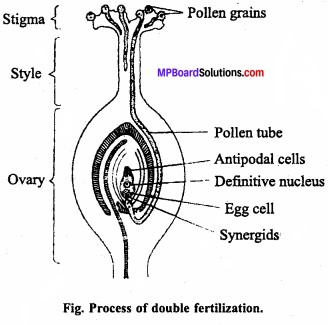MP Board Class 12th Biology Important Questions Chapter 2 Sexual Reproduction in Flowering Plants
Sexual Reproduction in Flowering Plants Important Questions
Sexual Reproduction in Flowering Plants Objective Type Questions
Question 1.
Choose the correct answers:
Question 1.
Apomixis in plants means the development of a plant :
(a) Fusion of gametes
(b) Without fusion of gametes
(c) Stem cuttings
(d) Root cuttings.
Answer:
(b) Without fusion of gametes
Question 2.
Polygonum type of embryo sac is :
(a) 8 – nucleated
(b) 16 – nucleated
(c) 24 – nucleated
(d) 32 – nucleated
Answer:
(a) 8 – nucleated
Question 3.
In angiosperms, female gametophyte is represented by :
(a) Synergids
(b) Carpel
(c) Egg
(d) Pollen grain
Answer:
(c) Egg
![]()
Question 4.
The term ‘xenia’ denotes the effect of pollen on the :
(a) Endosperm
(b) Flower
(c) Somatic tissue
(d) Root.
Answer:
(a) Endosperm
Question 5.
The fusion of male gamete with the secondary nucleus of the embryo sac is a process of:
(a) Fertilization
(b) Double fertilization
(c) Parthenocarpy
(d) Parthenogenesis.
Answer:
(b) Double fertilization
Question 6.
Which of the following is formed as a result of double fertilization :
(a) Endosperm
(b) Megaspore
(c) Seed
(d) Fruit.
Answer:
(a) Endosperm
Question 7.
What is the fusion product of polar nucleus and male gamete :
(a) Secondary nucleus
(b) Triple fusion
(c) Primary endosperm nucleus
(d) Zygote.
Answer:
(c) Primary endosperm nucleus
Question 8.
In which of the following plants, water is not necessary for fertilization :
(a) Vallisneria
(b) Pisus sativum
(c) Funaria
(d) Fern.
Answer:
(b) Pisus sativum
Question 9.
Tepetum is a part of :
(a) Male gametophyte
(b) Female gametophyte
(c) Ovary wall
(d) Anther wall.
Answer:
(d) Anther wall.
Question 10.
The endosperm is generally :
(a) Haploid
(b) Diploid
(c) Triploid
(d) Tetraploid
Answer:
(c) Triploid
Question 11.
The exine of pollen grain is made up of:
(a) Cellulose
(b) Pectdcellulose
(c) Lignin
(d) Sporopollenin
Answer:
(d) Sporopollenin
Question 12.
After fertilization ovary develops in to :
(a) Embryo
(b) Fruit
(c) Endosperm
(d) Seed
Answer:
(b) Fruit
Question 13.
A typical embryo sac is eight nuleate and :
(a) Single celled
(b) Seven celled
(c) Eight celled
(d) Four celled
Answer:
(b) Seven celled
![]()
Question 14.
Germ pore is the place where exine is :
(a) Thick
(b) Uniform
(c) Thick and Uniform
(d) Absent.
Answer:
(d) Absent.
Question 2.
Fill in the blanks:
- The main function of endosperm in embryo is ……………. storage.
- Type of pollination which occurs by birds is called …………….
- Apple is the example of ……………. fruit.
- Ovules are situated on these tissue is called …………….
- In sunflower ……………. types of anther is found.
- In plants fruit is formed by …………….
- Single cotyledon of maize is called …………….
- Outer membrane of pollen grain is called …………….
- Process of double fertilization is discoverd by …………….
- The process of pollination of Vallisneria is occurs by …………….
- The study of pollen grain is called …………….
- Smell and nectar is the adaptation of ……………. pollinated flowers.
- Pollination in cobra plant is occurs through the …………….
- Tetradynamous stamen are found in …………….
Answer:
- Food material
- Omithophily
- False fruit
- Placenta
- Syngenesious
- Ovary
- Scutellum
- Exine
- Nawaschin
- Water
- Palynology
- Insect
- Snail
- Mustard.
Question 3.
Match the followings :
I.
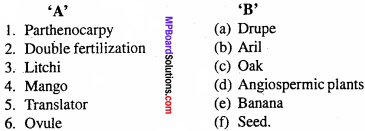
Answer:
- (e)
- (d)
- (b)
- (a)
- (c)
- (f)
II.

Answer:
- (c)
- (a)
- (d)
- (b)
Question 4.
Write the answer in one word/sentences:
- What is the ploidy of microspore tetrad?
- Which component prepare intine of the pollen grain?
- Name a scar on a seed marking the point of attachment of the ovule.
- Name the type of pollination in which found in Salvia.
- What is the ploidy of angiospermic endosperm.
- Stigma, style and oVary is the part of.
- Name the largest flower of the world.
- Name the plant in which found in longest style and stigma.
- Name the hormone which is induced the ovary in the form of fruit.
- Name the layer of pollen grain which has binuleated cell.
- Name the mass of cells which is produced in culture medium.
Answer:
- Haploid
- Cellulose and Pectin
- Hilum
- EntomophiIy
- Triploid
- Female gamete
- Rafflesia
- Maize
- Auxin
- Tapetum
- Callus.
Sexual Reproduction in Flowering Plants Very Short Answer Type Questions
Question 1.
Development of female gametophyte occurs in which cell?
Answer:
By functional megaspore mother cell.
Question 2.
What is the other name of female gametophyte?
Answer:
Embryo sac.
Question 3.
Ovule derives nourishment from which part of the carpel?
Answer:
Ovule derives nourishment from placenta.
Question 4.
What are cleistogamous flowers? Give an example.
Answer:
The flowers which do not open are called cleistogamous flowers, e.g., Commelina.
Question 5.
What is the substance found on the exine of pollen grains?
Answer:
Sparopollenin.
Question 6.
Give the characters of wind pollinated flowers.
Answer:
White in colour, small in size and.pollen grains are formed in large number.
Question 7.
What is the ploidy of angiospermic endosperm?
Answer:
Triploid.
![]()
Question 8.
Give an example of a monocotyledonous endospermic seed.
Answer:
Ricinus.
Question 9.
Give example of two false fruit.
Answer:
Apple, Jackfruit.
Question 10.
What are monocious plants ?
Answer:
Plants which have both male and female flower.
Sexual Reproduction in Flowering Plants Short Answer Type Questions
Question 1.
Write three merits of sexual reproduction in plants.
Answer:
- Due to sexual reproduction variations possibilities of evolution become more.
- Seeds thus produced can be preserved for years.
- It helps the plants to develop adaptations.
Question 2.
Name the parts of an angiosperm flower in which development of male and female gametophyte take place.
Answer:
Development of male gametophyte takes place in anther and female gametophyte in ovary.
Question 3.
Differentiate between microsporogenesis and megasporogenesis. Which type of cell division occurs during these events ? Name the structure formed at the end of these two events.
Answer:
Differences between Microsporogenesis and Megasporogenesis:
Microsporogenesis:
- In this process haploid microspores are formed from diploid microspore mother cell.
- The four microspores formed from a single microspore mother cell are generally aranged in a tetrahedral structure.
- All the four microspores arranged in a tetrahedral tetrad are functional.
Megasporogenesis:
- In this process, haploid megaspores are formed from diploid megaspore mother cell.
- The four megaspores formed from a me – gaspore mother cell are arranged in the from of a linear tetrad.
- Only one megaspore remain functional while the other three degenerates.
Meiosis occurs during micro and megasporogenesis. Microspores (pollen grain) are formed at the end of microsporogenesis and female gametophyte (embryo sac) are formed at the end of megasporogenesis.
Question 4.
Arrange the following terms in the correct developmental sequence :
Pollen grain, sporogenous tissue, microspore tetrad, pollen mother cell, male gametes.
Answer:
Sporogenous tissue → Pollen mother cell → Microspore → Tetrad → Pollen grain → Male gametes.
Question 5.
With a neat, labelled diagram, describe the parts of a typical angiosperm ovule.
Answer:
Structure of Ovule: Each ovule consists of the following parts as visible in a longitudinal section:
1. A small stalk or funicle by which the ovule remains attached with the placenta of the ovary.
2. Hilum is the point at which it is attached with the ovule. In inverted ovule the funicle fuses with the main body of the ovule and is called as raphe.
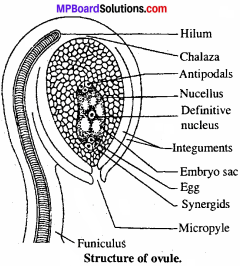
3. The ovule is surrounded on all sides by two integuments but not at the apex where an aperture called micropyle is present. This end of the ovule is called as micropylar, while the end of the ovule opposite to it is called as chalazal end.
4. Embryo sac is situated inside the nucellus.
5. Towards the micropyle end of embryo sac one egg or oospore and 2 synergids are found, and towards the chalaza end of embryo sac 3 antipodal cells are fpund. At the centre secondary nuclei is found.
![]()
Question 6.
Differentiate self – pollination and cross – pollination.
Answer:
Differences between Self and Cross – pollination:
Self – pollination:
- It is the process of transfer of pollen grains from one flower to the stigma of same flower or another flower of same plant.
- Medium is not required for pollination.
- Pollination is sure.
- Less number of pollen grains are produced.
- Plants do not show any special character.
- Pure breed can be obtained.
Cross – pollination:
- It is the process of transfer of pollen grains from one flower to the stigma of flower of another plant.
- Medium is required for pollination.
- Pollination depends on medium.
- More number of pollen grains are produced.
- Attractive, coloured, scent or honey bearing flowers are produced to attract insects.
- Hybrids are produced.
Question 7.
What is apomixis and what is its importance?
Answer:
Apomixis is the process of asexual production of seeds, without fertilisation. The plants that grow from these seeds are identical to the mother plant.
Uses:
- It is a cost effective method for producing seeds.
- It has great use for plant breeding when specific traits of a plant have to be preserved.
Question 8.
With a neat diagram explain the 7 – celIed, 8 – nucleate nature of the female gametophyte.
Answer:
Explanation:
Nucleus of the functional megaspore undergoes mitosis resulting in 2 – nuclei that move to two opposite poles forming 2 – nucleate embryo sac. Two more mitotic nuclear divisions result in 4 – nucleate and later 8 – nucleate stages of the embryo sac. so far no cytokinesis (cytoplasmic division) has taken place. Now cell walls start to build leading to the organisation of female gametophyte or embryo sac. Six of the 8 – nuclei are bound by cell wall and the ramaining 2 – celled polar nuclei lie below the egg apparatus in the large central cell.
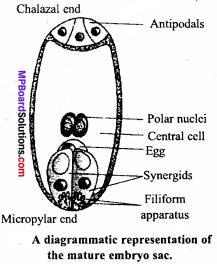
Seven – celled stage:
Three cells are grouped together at the micropylar end and constitute the egg apparatus, which is constituted of two synergids and one egg cell. Three cells at the chalazal end are called antipodals. The large central cell has 2 – polar nuclei. Thus, a typical angiosperm embryo sac at maturity is 7 – celled but 8 – nucleated as the central cell has 2 – nuclei.
Question 9.
What are chasmogamous flowers? Can cross – pollination occur in cleistogamous flower? Give reason for your answer.
Answer:
Chasmogamous flowers are open flowers with exposed stamens and stigma which facilitate cross – pollination. No cross – pollination occurs in cleistogamous flowers. As these flowers are closed and never open and thus no transfer of pollen from outside to stigma of the flower is possible. So there is no cross – pollination.
Question 10.
What is polyembryony?
Answer:
Polyembryony:
When more than one embryo develops in one seed then this condition is called as polyembryony. It is generally found in citrus family. It is also found in nicotiana, conifers, rice, wheat. It occurs when fertilization occurs in all embryo sacs found in the ovule,
Question 11.
Mention two strategies evolved to prevent self – pollination in flowers.
Answer:
Two strategies evolved to prevent self – pollination are:
- Pollen release and stigma receptivity is not synchronized.
- Anthers and stigma are placed at such positions that pollen doesn’t reach stigma.
Question 12.
What is self – incompatibility? Why does self – pollination not lead to seed formation in self – incompatible species?
Answer:
Self – incompatibility is a genetic mechanism to prevent self – pollen from fertilizing the ovules by inhibiting pollen germination or pollen tube growth in the pistil, In these cases, self – pollination does not lead to seed formation because fertilization is inhibited.
Question 13.
What is bagging technique? How is it useful in a plant breeding programme?
Answer:
It is the covering of female plant with butter paper or polythene to avoid their contamination from foreign pollens during breeding programme.
![]()
Question 14.
What is triple fusion? Where and how does it take place? Name the nuclei involved in triple fusion.
Answer:
Triple fusion refers to the process of fusion of three haploid nuclei. It takes place , in the embryo sac. The 3 – nuclei that fuse together are, nucleus of the male gamete and 2 – polar nuclei of the central cell to produce a triploid primary endosperm nucleus,
Question 15.
Why do you think the zygote is dormant for sometime in a fertilized ovule?
Answer:
The zygote is dormant in fertilized ovule for sometime because at this time, endosperm needs to develop. As endosperm is the source of nutrition for the developing j embryo, the nature ensures the formation of enough endosperm tissue before starting the process of embryogenesis.
Question 16.
Differenciate between:
(a) Hypocotyl and Epicotyl
(b) Colcoptile and Coleorhiza,
(c) Integument and Testa
(d) Perisperm and Pericarp.
Answer:
(a) Differences between Hypocotyl and Epicotyl:
Hypocotyl:
- The region of the embryonal axis that lies between the radicle and the point of attachment of cotyledons is called hypocotyl.
- Hypocotyl pushes the seed above the soil in epigeal germination.
- It is an important component of embryonic root system.
Epicotyl:
- The region of the embryonal axis that lies between the plumule and cotyledons is called epicotyl.
- Epicotyl pushes the plumule above the soil in hypogeal germination.
- It is an important component of embryonic shoot system.
(b) Differences between Coleoptile and Coleorhiza:
Coleoptile:
- The shoot apex and few leaf primordia are enclosed in epicotyl region is called coleoptile.
- It comes out of the soil.
Coleorhiza
- The redicle and rootcap are situated at the lower end of embryonal axis are enclosed by protective sheath called coleorhiza.
- It remains inside the soil.
(c) Differences between Integement and Testa:
Integument:
- It is the protective covering of the ovule.
- It is a part of pre fertilisation.
Testa:
- It is the protective covermg of the seed.
- It is a part of post fertilisation.
(d) Differences between Perisperm and Pericarp:
Perisperm:
- It is the part of nucellus which remains in form of thin layer after seed germination.
- It is a part that belongs to seed.
- It is usually dry.
Pericarp:
- Ovary is convert into pericarp after fertilisation.
- It is a part that belongs to fruit.
- It can be dry and fleshy.
Question 17.
Why is apple called a false fruit? Which part of the flower forms the fruit?
Answer:
Apple is called a false fruit because it develops from the thalamus instead of ovary (thalamus is the enlarged structure at the the base of the flower).
Question 18.
What is meant by emasculation? When and why does a plant breeder employ this technique?
Answer:
Emasculation means removal of anthers, with a forceps, from the flower bud before dehiscence. Plant breeder employs this technique to prevent contamination of stigma with the undesired pollen. This is useful in artificial hybridisation, where desired pollen is required.
Question 19.
If one can induce parthenocarpy through the application of growth sub – stances, which fruits would you select to induce parthenocarpy and why?
Answer:
Orange, lemon, litchi could be potential fruits for inducing the parthenocarpy because seedless variety of these fruits would be much appreciated by the consumers.
Sexual Reproduction in Flowering Plants Long Answer Type Questions
Question 1.
Describe structure of ovule with labelled diagram.
Answer:
Structure of Ovule:
Each ovule consists of the following parts as visible in a longitudinal section:
1. A small stalk or funicle by which the ovule remains attached with the placenta of the ovary.
2. Hilum is the point at which it is attached with the ovule. In inverted ovule the funicle fuses with the main body of the ovule and is called as raphe.
3. The ovule is surrounded on all sides by two integuments but not at the apex where an aperture called micropyle is present. This end of the ovule is called as micropylar, while the end of the ovule opposite to it is called as chalazal end.

4. Embryo sac is situated inside the nucellus.
5. Towards the micropyle end of embryo sac one egg or oospore and 2 synergids are found, and towards the chalaza end of embryo sac 3 antipodal cells are found. At the centre secondary nuclei is found.
Question 2.
Describe structure of anther with labelled diagram.
Answer:
Structure of Anther:
Transverse section of anther shows that it consists of 2 lobes which are connected by connective. Each lobe contains two pollen sacs. Innermost layer of pollen sac is called as tapetum. Tapetum is a layer rich in nutritive contents which supplies food material for the developing pollen grains. At first many pollen mother cells are formed in them which divides meiotically to form haploid pollen grains.
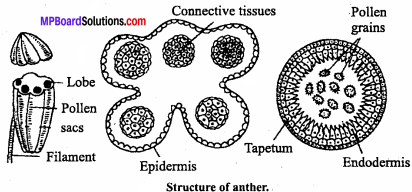
Question 3.
Give four contrivances for self – pollination.
Answer:
Contrivances for self – pollination:
1. Bisexuality:
When male and female parts are found in same flower then possibility of self – pollination increases.
2. Cleistogamy:
In Commelina benghalensis both cleistogamous and chasmogamous flowers are produced. The former are the underground flowers and the latter are the aerial ones developed on branches. In the small, inconspicuous cleistogamous flowers the pollen are shed within the closed flowers so that self – pollination is a must. This is also observed in Impatiens, Oxalis, Viola, Portulaca etc.
3. Homogamy:
Here the stamens and carpels mature at the same time. So, there is a greater chance of self – pollination as compared to cross – pollination, example Mirabilis, Argemone etc.
4. Failure of cross – pollination:
In some flowers generally cross pollination occurs but if they fails to do cross-pollination then self pollination occurs.
![]()
Question 4.
What do you mean by micropropagation?
Answer:
Micropropagation:
It is a modem method of reproduction. By this process thousands of new plants can be obtained from few tissues of mother plant. This method is based on tissue and cell culture technique. In this process a small part of tissue is separated from the plant and then it is grown in nutrient medium in aseptic condition. The tissue develops to form a cluster of cells which is called as callus.
This callus can be preserved for long time for multiplication. A small part of the callus is transferred to nutrient medium, where it grows into a new plant. This plant is then transferred to the field. By this process Orchids, Carnations, Chrysanthemum plants can be grown successfully.
Question 5.
What is self – pollination? Give advantages and disadvantages of self – pollination.
Answer:
Self – pollination:
When the pollen grain of one flower are transferred to the stigma of the same flower then the process is called as self – pollination.
Advantages of self – pollination : These are the advantages of self – pollination:
- Parental characters can be preserved indefinitely in several generations.
- Self – pollination helps in maintaining pure lines for experimental hybridization.
- It is most economical method of pollination. The plants do not consume their energies in the production of large number of pollen grains, nectar and coloured corolla.
- It ensures seed production and flowers do not take chances of the failure of fertilization.
Disadvantages of self – pollination : These are the disadvantages of self – pollination:
- The weaker characteristics or defects of the plant can never be eliminated from the race.
- No useful characters can be introduced in the race.
- The immunity of race towards diseases falls and ultimately it falls prey to many diseases.
![]()
Question 6.
Describe development of endosperm.
Answer:
Development of endosperm:
It develops from the triploid tissue of the fertilized embryo sac after the act of double fertilization. It is of the following three types:
- Free nuclear endosperm.
- Cellular type of endosperm.
- Helobial type of endosperm.
The name refers to the type of nuclear divisions of the endosperm nucleus. If triploid nucleus divides by free nuclear division the endosperm produced contains many nuclei ly¬ing freely in it and hence it is termed as free nuclear endosperm. If the nuclear division is followed by wall formation it is called as cellular type. If endosperm is intermediate between the two types it is called as helobial type.
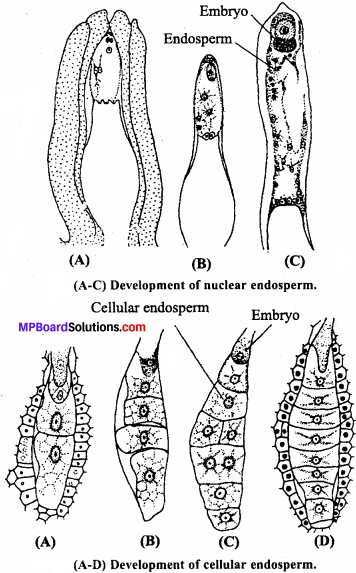
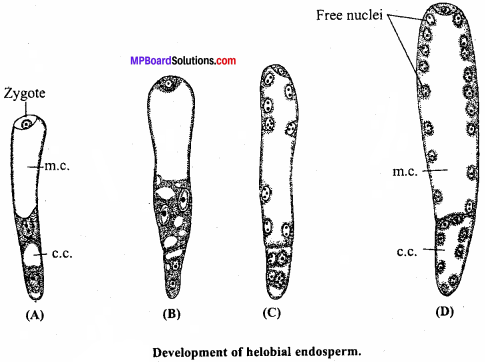
Question 7.
Differentiate between:
- Embryo sac and Endosperm,
- Seed and Ovule.
Answer:
1. Differences between Embryo sac and Endosperm:
Embryo sac:
- It is haploid structure.
- It is found in ovule.
- It is formed before fertilization.
- Nutritive materials are stored.
- It consists of antipodal cells, egg cell, synergid cells and two polar nuclei.
Endosperm:
- It is triploid structure.
- It is found in seed.
- It is formed after fertilization.
- Nutritive materials are not stored.
- Antipodal cells, egg cell, synergid cells are absent and all cells are similar
2. Differences between Seed and Ovule:
Seed:
- It is formed in the fruit seed is formed after fertilization of ovule.
- Seed is surrounded by integument. Outer covering is called outer integument and inner covering is called inner integument.
- Embryosac is absent in seed.
- Embryo is present in seed
- Endosperm may be found in seed
- Seed germinates to produce new paint.
Ovule:
- Before fertilization ovule is found into the ovary called mega sporangium.
- Nucellus is present below the ovule and is surrounded by inner and outer covering.
- Embryosac is present in ovule.
- Embryo is absent in ovule.
- Endosperm is not found in ovule.
- Ovule does not germinate.
![]()
Question 8.
Explain any five differences between pollination and fertilization.
Answer:
Differences between Pollination and Fertilization:
Pollination:
- In pollination, pollen grains are transferred from stamens to stigma of the flower.
- Two male gametes are formed in this process.
- Haploid cells participating in this process.
- A medium is required for this process.
- There is no morphological change after this process.
Fertilization:
- Fertilization is a process in whieh male and female gametes fused to form the zygote.
- Zygote is formed at the end of this process.
- Haploid cells fused to form a diploid cell.
- Medium is not required for this process.
- Flower is modified into fruit and seed after this process.
Question 9.
What do you understand by double fertilization? Write its importance.
Answer:
Double fertilization:
It is the process of fusion of one male gamete with the egg nucleus and other male gamete with the polar nuclei or secondary nucleus is called double fertilization. In all angiospermic plants there is double fertilization. This process was discovered by S. N. Navaschin (1898) and Grignard (1899) in Lilium and Fritillaria. In this process, pollen grains reach stigma and then germinate. A short pollen tube comes out through a germpore. The pollen grain nucleus divides mitotically into a tube nucleus and a generative nucleus. The generative nucleus again divides into two male nuclei.
The pollen tube may enter the ovule through micropyle or through integuments or through chalazal end. One of the two male nuclei fuses with the egg nucleus and forms a zygote and this process is called syngamy. The male nucleus fuses with the two polar nuclei or secondary nucleus (diploid) and gives rise to triploid primary endosperm nucleus. This process is called triple fusion and whole process is called double fertilization. This triploid nucleus forms endosperm of the seed.
Importance:
After double fertilization triploid nucleus (endosperm nucleus) developed to form an endosperm which provide nourishment to the developing embryo resulting in the formation of healthy seed and plant.
